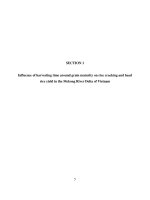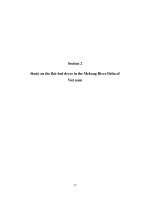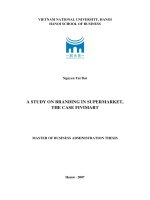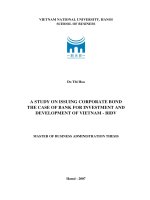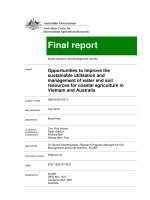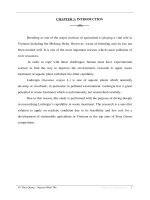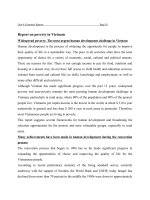IMPACTS OF CLIMATE CHANGE ON AGRICULTURE IN VIETNAM The case of Mekong River Delta, Vietnam
Bạn đang xem bản rút gọn của tài liệu. Xem và tải ngay bản đầy đủ của tài liệu tại đây (136.05 KB, 9 trang )
FINAL EXAMINATION PAPER, 2012 BY NGUYEN THANH TAN,
Thai Nguyen University of Agriculture and Forestry
November 2012
IMPACTS OF CLIMATE CHANGE ON AGRICULTURE IN
VIETNAM
The case of Mekong River Delta, Vietnam
By
NGUYEN THANH TAN
Student of Advanced Education Program,
Thai Nguyen University of Agriculture and Forestry
Email address:
The course of Modern Agriculture Issues, Implications and Impacts
Professor William Steiner, Dean of the College of Agriculture,
Forestry and Natural Resource Management, University of Hawaii, Hilo
November 25, 2012
1
FINAL EXAMINATION PAPER, 2012 BY NGUYEN THANH TAN,
TABLE OF CONTENT
ABSTRACT........................................................................................................ 3
INTRODUCTION…………………………………………………................. 4
• The realities of climate change in Viet nam, particular in Mekong
River Delta…………………………………........................................... 4
• Challenges and impacts to agricultural sector in Vietnam and
Mekong River Delta River in particular............................................... 4
• Interventions policy and solutions......................................................... 5
DISCUSSION AND SUGESSION.................................................................. 6
CONCLUTION AND URGENT ACTION NOW......................................... 8
REFERENCES.................................................................................................. 9
2
FINAL EXAMINATION PAPER, 2012 BY NGUYEN THANH TAN,
ABSTRACT
Climate change is already happening. Regardless of international progress to
reduce emissions of the greenhouse gases that cause climate change, the climate
system will continue to adjust for the next few decades to past and present
emissions. This will bring unavoidable impacts to all countries in the world,
especially to the North American, European and Southeast Asian countries
(Heather Haydock, AEA Energy & Environment, 2007).Vietnam is in the south-
eastern extremity of the Indochinese peninsula and occupies about 331,688
square kilometers. With a coastline of 3,260 kilometers, and more than one
million square kilometers of sea surface, Vietnam is likely to be among the
country hardest hit by climate change, mainly through rising sea levels and
changes in rainfall and temperatures (Human development report 2007/2008).
The changing climate is tend to increase intensity and number of natural
disasters as storm surge, flash flood, whirlwind, desertification, inundation, etc.,
and impacts society and ecosystems in a broad variety of ways. Being an
agriculture country, Vietnam can be extensively affected by climate changes on
agriculture production and economic growth.
This paper examines these main impacts of climate change on agriculture in
Mekong River Delta, one of the most important two rice granaries of the
country, alongside Red River Delta in the North, and one of the largest inland
fisheries in the world (MRC, 2009). I first assess the impacts of climate change
on Agricultural system in the River Delta area based on rice sectors, and forestry
and fishery so far. I then present a yield function approach that models
technology advances and policy interventions to improve rice productivity and
mitigate the impact of climate change. There are synergies between climate
change study and crop production analysis that can improve our understanding
of long-term food security. This analysis integrates rice yield response to inputs,
technical change, and policy interventions with impact assessment of climate
change on agricultural sectors.
It is estimated that annual rice production of Mekong Delta River may be
reduced by 2.7 millions tons by 2050 under climate change (World Bank, 2010).
Nevertheless, government investment in rural infrastructure and human capital
can mitigate the negative impact of climate change and help farmers adapt. The
result indicates that government investment in Mekong River Delta has the
highest return in agricultural production and poverty reduction, far above
education, road, and irrigation. In preparation for future climate change, it is
important to invest in agricultural rural and development in order to supply
farmers with more drought- and flood-tolerant crop varieties and highly efficient
production practices that are more resilient in adverse soil and weather
conditions.
Keywords: Climate change, agriculture productivity, policy intervention, Mekong River
Delta, Vietnam.
3
FINAL EXAMINATION PAPER, 2012 BY NGUYEN THANH TAN,
INTRODUCTION
This chapter provides an overview of realities of climate change, and the
challenges, impacts to agricultural sector in Vietnam in general and in Mekong
River Delta River in particular. Finally, I will introduce and recommend some
interventions policy and solutions to overcome and adapt to climate change.
The realities of climate change
Climate change is more than a threat; it’s a reality for millions of people in
Vietnam. The impacts of climate change are already destroying livelihoods and
increasing financial, political, social and environmental inequities. Hundreds of
people in the coastal community of Da Loc were heavily damaged by typhoon
Damarely in 2005. Already a million hectares of rice paddy fields have been
contaminated by salt water along the country. The Vietnamese government has
begun planning for a one meter rise in sea level by the end of the century. The
consequences of doing nothing would see more than a third of the Mekong Delta
flooded by then. A spokeswoman for the Tra Vinh Commune People’s
Committee was direct: “I can tell you climate change is having a big impact on
agricultural production and on the lives of the people because of the intensified
drought, the saline water coming in, as well as the stormy weather. They’ve all
had a very negative effect on agriculture and as a result on the income of the
farmers”.
The impacts of climate change
Changes in climate can have serious implications for economic development,
especially in the agricultural sector, due to its direct exposure to and dependence
on weather and other natural conditions. Studies for the Southeast Asian region
show that climate change could lower agricultural productivity by 2–15 percent
in Vietnam (Zhai and Zhuang 2010).
Mekong River Delta and the coastal areas in the north of the central region are
most vulnerable to the impact of global warming in Vietnam due to rising sea
levels. Each year, Mekong people can harvest up to 2.6 million tons of wild fish
and other aquatic resources (MRC, 2009) as the world’s largest island fishery.
The Delta provides 90 per cent of rice exports, and Vietnam is one of the
world’s top suppliers of this staple. It meets more than half of the country’s fruit
and seafood needs, and the majority of seafood exports. This food production
adds up to about 20 per cent of the country’s GDP. It is really the largest
agriculture and aquaculture production region of Vietnam. Then what a picture
to Vietnamese agriculture if Mekong River Delta is affected strongly by climate
change! The effects of a changing climate could trigger destabilizing economic
and political forces, domestic impact altering regional geopolitics, international
trade and more.
Over last 30 years, average temperature increase of 0.5
o
C in Can Tho (the
largest city in Mekong River Delta), and the average sea level rise of 3 mm per
year in the water around the mouth of the Delta (ICEM, 4-5). The average
4
FINAL EXAMINATION PAPER, 2012 BY NGUYEN THANH TAN,
elevation of Mekong River Delta is roughly five feet above sea level, which
makes it particularly vulnerable to rising sea levels (Yun, 2009). It is estimated
that about 20–30 percent of the Mekong River Delta will be affected by 2100,
and some areas will be salinity (World Bank 2009). IPPC (2007) has warned
that if the sea level rises 1 meter, the Mekong Delta may lose 15,000 – 20,000
km
2
of land, and out 3.5 to 5.0 million of people will be affected. In fact, one-
fourth of the Mekong Delta coastline is already undergoing erosion. More dams
would likely increase this erosion as well as relative sea level rise, and might
worsen water shortages and extend the area affected by salinity during the dry
months. The changing climate could be especially damaging for rice cultivation
due to substantial modifications in land and water resources. It is predicted that
annual rice production of Mekong Delta River may be reduced by 2.7 millions
tons by 2050 under climate change (World Bank, 2010). Furthermore, the
appearances of extreme disasters such as typhoons, floods, and droughts, which
could become more severe and more frequent as the climate changes, would also
affect rice production substantially in the country, because it may lead to many
negative effects on quantity and quality of water supply and food security.
Moreover, the water in the common integrated agriculture-aquaculture system,
which is an efficient farming system supplying both rice and fish/shrimp for
farmers, is unbalanced between rice and fish under the impact of rising sea level.
Because fish is raised mainly in water bodies around rice fields to consume
agricultural by-products and wastes, the failure in each growing state will affect
the others. The change in monthly rainfall distribution such as less rains in early
wet seasons and more heavy rains in the end of the wet reduced rice production.
Rice yields decline 10% with 1
o
C increase in minimum temperature (Peng et al.,
2004). Almost all fish and shrimp species develop favorably in optimum water
in the range of 20
o
C to 25
o
C. Aquaculture yields may decline precipitously at
water temperature above 30
o
C especially as dry lands expands.
Otherwise, the high humidity and temperature air are good conditions for
insect species development. A higher of infectious diseases is also forecasted for
the area (MRC, 2009). Increased insect species will threat agriculture yields and
farmers income. Temperature increase plus the natural flow decrease may lead
to dissolved oxygen concentration in water bodies. Water-borne diseases will be
extended and attack rice-fish-shrimp farmers. Additionally, low flow, high
temperature and less oxygen in water bodies will affect the fish reproduction and
growth. Great variation in the flow of the Mekong River, from seasonal flooding
and low water levels, both drives and constrains the productivity of the agro-and
aqua-ecological systems.
Coastal and estuarine mangrove forest wetlands and other submerged aquatic
vegetation as habit and nutrient sources for fish species affected by sea level
rise. All farmers and agricultural enterprises will be failure on their business due
to the lack of essential nutrient sources, land ownership, financial sources and
information assessment under the climate and regime change. It does not have
significant impacts to agriculture sectors but also to local social problems
5
FINAL EXAMINATION PAPER, 2012 BY NGUYEN THANH TAN,
influenced by a wide range of local, regional, national and international trade
policies.
Interventions policy and solutions
Recognizing potential impacts of climate change, the government of Vietnam
has created a legal framework on sustainable development and climate change
including Viet Nam Agenda 21, the Law on Environmental Protection, disaster
risk mitigation policies, and energy efficiency policies. The implementation of
the framework will substantially improve the living conditions of local
population in Mekong River Delta, protecting themselves and their production
from natural resources and seasonal floods. The project will also initiate socio-
economic development to maintain the Mekong River Delta one of the best rice
production area in the world and diversify local livelihoods to integrate to the
development trend of the country in particular and of the international region as
a whole.
With the main objectives are to strictly protect and manage rice land, many
organizations and agencies acting on climate change sector such as Can Tho
(11/20/2008), Institute of Climate Change Research – Can Tho University
(DRAGON – Mekong – CTU in short), etc. was established; and many research
programs were developed on rice cultivated land to map growing areas for rice
are encouraging by government. They did make a “red line” border in reality for
specialized paddy rice areas and revise some articles of the Land Law 2003 and
issue a government degree on management of rice land. Since 2001, the
governments have increased investment and supplementing budget for rural and
infrastructure development of Mekong River Delta, encouraging the application
of mechanization in food production, harvesting, processing and storage.
Furthermore, it was enhanced public awareness, responsibility and participation,
and develops human resources to respond to climate change. To balance the
floor price for agricultural products which ensure food price subsidy for poor
households and low income groups whenever food prices increased, the
government continues applying reduction fee of free irrigation, increasing to buy
food reserve and support food enterprises to build their facilities for storage and
renewing rice export mechanism.
DISCUSSION AND SUGGESTION
Climate change has great impacts on the whole society. Therefore, it is the
responsibility of government from central to local to implement programs of
climate change, especially activities related to adaptation to climate change. The
government guides all related activities including integrating climate change
into policies, plans, and national fund development. For the Mekong Delta, the
long term responsibility of government is to contribute to the mitigation of the
area’s vulnerability by impacts of climate change through regulating
governmental and non – governmental organizations, developing policies and
enhancing coping and adapting ability to climate change to ensure the
sustainability of the environment, the economic and social equality. It also is
6
FINAL EXAMINATION PAPER, 2012 BY NGUYEN THANH TAN,
responsibility of the whole society to protect natural resources and the
environment.
However, we still have some limitations and weaknesses in the fight against
climate change and maintain Mekong River Delta. For examples, the assessment
of temperature and sea level variation is not really detailed for zones and not
comprehensive. The impacts of land use change is not taken into consideration
when assessing temperature change trends and the impacts of tide, water surge
due to wind and subsidence are still not eliminated when assessing water level
change. Because we still lack of basic survey data; the flow pattern change due
to change of reservoirs built upstream. There are still not enough legal
documents on climate change response. Some documents lack legal basis to
regulate activities related to climate change. Additionally we lack of a specific
mechanism for co-operation among departments, branches and local offices as
well as a mechanism for participating and co-operating with the society and the
communities in programs to respond to climate change. Therefore, this legal
document system needs to be supplemented and completed as soon as possible
to meet practical demand of society on sustainable development and climate
change mitigation.
Capacity of organizations doesn’t really meet the requirements to cope and
adapt to climate change. So, it is necessary to improve the capacity, equipment
and co-operation between organizations. Private sector has shown their
responsibility on coping with climate change through many activities such as
greenhouse gas emission surveillance, decreasing power consumption and
developing clean energy. However, this contribution is still restricted and not
specific. This may be due to administrative policies. To cope and mitigate the
impacts of climate changes, it’s necessary to study in depth for each area,
enhance forecasting capacity and improve the accuracy and detail of climate
change scenarios.
Suggestions of Sihymete for next steps (from December 2010 to May
2011):
• Importing and processing meteorological data from 13 monitoring
stations in Mekong Delta. The collected data include: temperature,
rainfall, evaporation, sun hours, wind speed and direction. Data type is
daily. Collecting period is from 1978 to 2009.
• Importing and processing water level data from monitoring stations in
Mekong Delta. Data collected is hourly data. Collecting period is from
1978 to 2009.
• Importing and processing salinity data at monitoring stations in
Mekong Delta. Assessing climate fluctuation in 5 sub – areas of
Mekong Delta (Long Xuyen Rectangle, Ca Mau peninsula, Dong
Thap Muoi, Tien – Hau river and the Eastern coastal zone)
• Assessing salt intrusion trends in seasons; water level trends in
monitoring stations. Making maps of water level trends in the period
7
FINAL EXAMINATION PAPER, 2012 BY NGUYEN THANH TAN,
1978 – 2009.
• Building climate change scenarios for 5 sub areas of the Mekong
Delta to 2100.
• Analyzing and assessing impacts on Mekong Delta in climate change
scenarios.
• Researching in detail impacts of climate change on inundation, salt
intrusion,
• Water resources and agricultural production to propose coping
solutions.
Sources: Ministry of Natural Resources and Environment: Department of
Meteorology, Hydrology and Climate Change
CONCLUSION AND URGENT ACTION NOW
The Mekong River Delta is critically important to Vietnam’s national
agricultural production. However, under the impacts of climate change already
affecting the Mekong Delta, prolonged inundation of fields and increased
salinity threaten the viability of three-season rice farming in this densely
populated, low-lying region, and could directly affect 1 million people by 2050.
Therefore, it is responsibility of government from central to local to implement
programs of climate change, especially activities related to adaptation to climate
change; and also is responsibility of the whole society to protect natural
resources and the environment. If we do nothing to reduce our carbon emissions,
a third of Mekong River Delta lies barely more than 6.6 feet (2 meters) above
sea level could be flooded every year with a sea level rise of 3.3 feet (1 meter).
Because around 78 percent of the delta's land is used for rice production, such
flooding today would cause approximately $17 billion in economic losses - a
substantial percentage of Vietnam's gross domestic product. If, on the other
hand, we make significant efforts to reduce emissions,
sea level rise between
now and the end of the century could be limited to 15 inches (38 centimeters)
(Union of Concerned Scientists, 2011).
In preparation for future climate change, it is important to invest in agricultural
rural and development in order to supply farmers with more drought- and flood-
tolerant crop varieties and highly efficient production practices that are more
resilient in adverse soil and weather conditions. Research should be carried out
on the construction of sea and river dykes, the construction of fresh water
reservoirs for the dry season and how to recharge groundwater reservoirs.
Planned infrastructural measures for adapting to climate change must address
the whole of the Mekong River Delta, not Can Tho alone. Awareness and
understanding of climate change for local people and government officials is
essential. Support from the international community is needed to help Can Tho
and the Mekong River Delta to find optimal and appropriate measures for
adaptation (ICEM, 5).
Collectively, numerous efforts such as these have already been undertaken by
both national and local government officials in Vietnam as well as across the
8
FINAL EXAMINATION PAPER, 2012 BY NGUYEN THANH TAN,
international community to support the Mekong River Delta in adapting to the
growing impacts of climate change. At this point in time, however, whether
these efforts can prevent either mass migrations of refugees from the Mekong
River Delta or corresponding conflicts from occurring is indeterminate.
REFERENCES
⌂ Related Information and Sources:
1. Wassmann, R., N.X. Hien, C.T. Hoanh, and T.P. Tuong. 2004. Sea level rise
affecting the Vietnamese Mekong Delta: Water elevation in the flood season and
implications for rice production. Climatic Change66:89-107.
2. Sub-Institute of Hydrometeorology and environment of South Vietnam: Vietnam-
Netherlands Mekong Delta, Master plan project, Ho Chi Minh City, 2010.
3. The Vietnam Water Partnership, Report on Climate change activities in Vietnam.
Ha Noi, December, 2010.
4. Nguyen Vu Hoan, M.Eng, Climate Change and Food Security in Vietnam,
Deputy Director of General Affairs Division, ICD Deputy Director of General
Affairs Division, ICD- -MARD MARD
⌂ Relevant Websites and Literature
1. Ardiansyah, Fitrian, and Putri, Desak (2011 February). "Risk and Resilience in
Three Southeast Asian Cross-Border Areas: The Greater Mekong Sub region, the
Heart of Borneo and the Coral Triangle." Retrieved September 11, 2011,
from: />three-southeast-asian-cross-border-areas-the-greater-mekong-sub-region-the-
heart-of-borneo-and-the-coral-triangle/
2. CENTRA Technology, Inc., and Suitor Corporation (2010 January). "Southeast
Asia: The Impact of Climate Change to 2030 - Geopolitical Implications."
Retrieved November 22, 2011, from the National Intelligence
Council: />3. International Centre for Environmental Management (ICEM) (2009, November
12 – 13). Mekong Delta Climate Change Forum Report Volume I. Retrieved
September 11, 2011, from the International Centre for Environmental
Management: />page.htm
4. Nguyen, Huu (2007). "Flooding in Mekong River Delta, Vietnam". Retrieved
September 27, 2011, from the Human Development Report
Office: />sa=t&rct=j&q=&esrc=s&source=web&cd=1&ved=0CB0QFjAA&url=http%3A%2F
%2Fhdr.undp.org%2Fen%2Freports%2Fglobal%2Fhdr2007-8%2Fpapers
%2FNguyen_Huu%2520Ninh.pdf&ei=mUnRTunxE-
jj0QGA0MyZBQ&usg=AFQjCNHSW-fz_3yVv36Sr6HgOfkhMrdNrw
9

